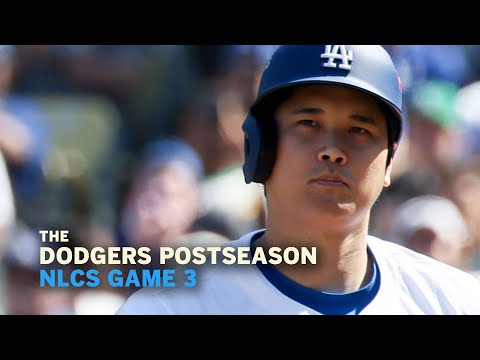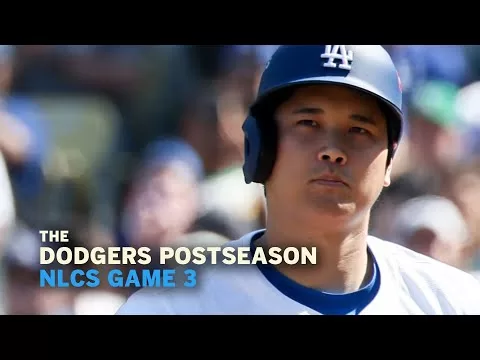Sometimes, Dodgers manager Dave Roberts said, all it takes one bad matchup, or one crafty pitcher, for a hitter to “trigger bad habits” in their swing.
In the case of Shohei Ohtani, and his struggles over the last several games of the Dodgers’ postseason, the culprit appears to have been San Diego Padres starter Yu Darvish.
In six at-bats against Darvish during last week’s National League Division Series, Ohtani went hitless, striking out three times while looking atypically mortal after his superhuman regular season.
In Game 5 of the NLDS, Ohtani seemed particularly uncomfortable against Darvish in the box. He went down on strikes chasing a slider out of the zone. He hit a lazy pop-up on a cutter down the middle. He struck out again chasing a curveball off the plate.

Before that game, Ohtani was off to a decent — though only occasionally dominant — first career postseason, collecting four hits and four RBIs over his first four games.
Starting with that 0-for-4 performance in Game 5, however, Ohtani hasn’t looked like himself.
He bashed one ball off the wall in Game 1 of the NL Championship Series against the New York Mets. But his only other hit over the past three games came on a slow roller Pete Alonso misread at first base.
Overall, Ohtani is just two for his last 12 with six strikeouts and only one RBI. On the whole this October, he also remains hitless when the bases have been empty, going 0 for 19 in such situations compared to a six-for-eight mark when the pitcher had a runner to worry about.
Asked about all this Tuesday, during an off-day ahead of the New York swing of the best-of-seven championship series, Roberts pointed back to Ohtani’s struggles against Darvish — and the bad habits, like chasing pitches out of the zone and failing to use the “big part of the field,” that have not-so-coincidentally followed.
“I was surprised with [his at-bats against] Darvish,” Roberts said. “I was surprised that he expanded [the strike zone] versus Darvish.”
And going into Game 3 on Wednesday night, Ohtani and the Dodgers are still trying to rectify his slumping form ever since, hoping the soon-to-be three-time MVP can improve upon his .222 batting average and .677 OPS so far this postseason.
“I think my feel isn’t bad,” Ohtani said in Japanese. “Rather than make big changes, I [want to] continue the good points from the regular season.”
One thing that certainly isn’t changing for now is Ohtani’s role as the Dodgers’ leadoff hitter.
After Roberts said Monday he hadn’t given much thought to dropping Ohtani in the batting order, despite his struggles with the bases empty, the manager doubled down on that point during his Tuesday news conference, explaining he still wants his $700-million superstar getting as many at-bats as possible.
“It’s just funny how things change,” Roberts said, recalling early-season concern over Ohtani’s ability to hit with runners in scoring position; a split in which Ohtani has thrived lately, going four-for-five in such spots in the playoffs.
“There was a lot of concern [early in the season] about Shohei not being able to get hits with the runners in scoring position,” Roberts added. “And now we’re all trying to find ways that — [we] have to get guys on base so he can hit, right? I kind of find that comical, a little bit.”
The tone of Roberts’ answer reflected his unwavering confidence in the 30-year-old slugger.
In his eyes, the keys to Ohtani’s success are the same as they have been all year.
“He’s got to continue to manage his hitting zone, regardless of who’s pitching,” Roberts said, noting that while Ohtani went quiet against Darvish, Padres left-handed reliever Tanner Scott (four strikeouts in the NLDS) and Mets Game 2 starter Sean Manaea (another lefty that held him hitless in three at-bats), he has looked fine against everyone else he’s faced.
Mets veteran Luis Severino will offer a new test in Game 3.
While discussing the matchups with Darvish on Tuesday, Ohtani noted that “there was a gap” between his memories of facing Darvish in the past, and the way his Japanese countryman attacked him in the NLDS.
Those differences, Ohtani said, resulted in foul balls on pitches he felt like he could have done damage.
“Right now, I think there’s more of that,” Ohtani said. “My approach to swinging when the ball comes in the strike zone.”
Facing Severino could present a similar dynamic.
While Ohtani is three-for-six with a home run and double in his career against Severino, he has faced him in just one game since 2018, recording two hits against the pitchers last year while Ohtani was with the Angels and Severino pitched for the Yankees.
Because of that, Ohtani said he wanted to “get a solid impression” of Severino in his first plate appearance Wednesday, one he could use for subsequent trips to the plate.
Of course, it would be nice for the Dodgers if Ohtani snapped his empty-bases drought in that leadoff at-bat too — and started to regain his historic regular-season form.
“My expectation,” Roberts said, “is that he’s going to reset today, get to the big part of the field [tomorrow] and take some good at-bats off Severino.”
